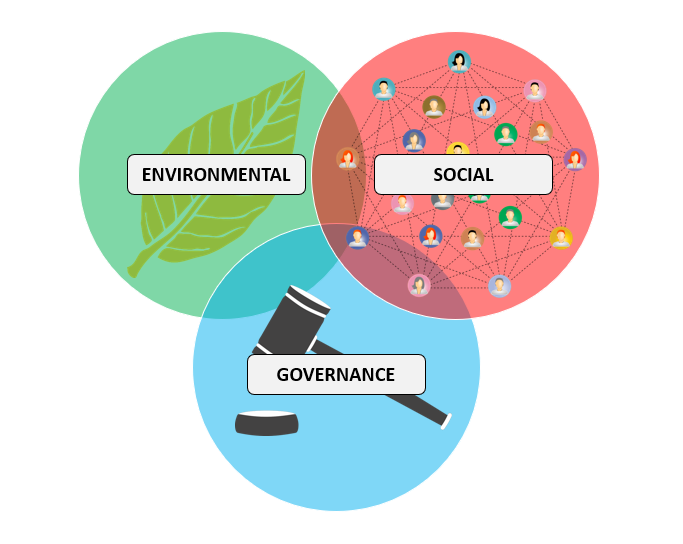What is ESG Investing?
Environmental, social, and governance (ESG) refers to the three central factors in measuring the sustainability and ethical impact of an investment in a company or business. ESG Investing then, is a holistic approach to investing that incorporates these critical factors into the investment analysis and decision-making process for an organisation.
ESG Investing is often used synonymously with socially-driven finance, with terms such as Socially Responsible Investing (SRI), Sustainable Investing (SI), Responsible Investing (RI), and mission-related investing.
In their recent report, Driving ESG Investing in Asia, AVPN focuses on the seven responsible investment strategies, which the Global Sustainable Investment Alliance (GSIA) has devised to classify forms of responsible investing, namely:
- Negative/exclusionary screening: Exclusion of certain sectors, companies, or practices based on specific ESG criteria
- Positive/best-in-class screening: Selection of investments based on positive ESG performance relative to industry peers
- Norms-based screening: Screening of investments against generally accepted minimum standards of business principles and practices
- ESG integration: Systematic inclusion of ESG factors into financial analysis
- Sustainability themed investing: Investment in themes such as water, clean energy, or sustainable agriculture
- Corporate engagement and shareholder action: Private markets investment aimed at solving specific social or environmental problems
- Impact/community investing: Influencing company behavior about ESG practices and policies through direct corporate engagement, and proxy voting among others.
There is an observed trend of social investments moving into ESG compliant entities, with the investors driving this move being institutions (wealth management and retail arms of banks), PE/VC Funds, and family offices. In their report, AVPN looks at ESG adoption globally, and then, based on the experiences and insights of a sample group of members based in Asia (who are at different stages of their ESG Investing journeys), provides key learnings and recommendations for those aiming to embark on similar journeys.
Factors driving ESG adoption
The last decade has seen significant developments in the ESG Investing landscape globally.
Investors are becoming cognizant of the fact that competitive financial returns can be generated alongside social and environmental progress, and are beginning to embrace international standards of sustainability. The launch of the Principles of Responsible Investing (PRI) network in 2006 by the United Nations (UN), and more recently the UN Sustainable Development Goals are exemplary milestones in this evolution.
Related article: The need to invest in climate change education
Factors influencing the adoption of ESG Investing globally include:
- Resilience it can offer in times of uncertainty: A 2018 global perception risk survey by the World Economic Forum indicates that most business leaders are widely concerned about the year ahead, which is largely on account of intensifying global risks emanating from political tensions, environmental threats, and cyber vulnerabilities. Fortunately, ESG Investing can overcome this issue, according to another global survey of institutional investors on responsible investing.
- Evidence that ESG-aligned funds perform at par with benchmark indices: Another study by Deutsche Bank found that 89 percent of these had observed companies with high ESG ratings outperformed the market. In addition, reliable empirical evidence has emerged that companies with better ESG practices are more profitable, trade at premium valuations to competitors, and are associated with long-term financial value creation.
- Certain demographic groups: Millennials are twice as likely to invest in companies or funds that target social or environmental outcomes. In addition, 80 percent women are observed to be keen investors in ESG as opposed to 60 percent of men, and the trend will continue with woman’s rising financial independence.

ESG Investing in Asia: The challenges
Despite these global drivers, adoption of ESG Investing in Asia has been comparatively slow. This low take-up rate is indicative of a less mature ESG Investing environment, but can also be attributed to the following:
- Traditional mindset that separates business and impact: Private investors in Asia have typically viewed investment and social activities as separate and distinct. Philanthropy and foundations have flourished and delivered significant social impact, but there still remains some resistance to translating this philosophy into a lens that factors this into investment decisions and financial performance. Investors in Asia tend to focus on profits and financial performance alone, despite evidence that integrating ESG policies drives long-term value creation.
- Knowledge and capability gaps: ESG considerations are constantly evolving, are broad-based, and differ by industry. This makes it cumbersome and difficult for investors to find strategies suitable for them. Some interviewees noted that they do not have the human capital with the requisite expertise to measure ESG factors and considerations. They are discouraged and daunted by the range of responsibilities that ESG Investing entails. Given these complications, some capital owners think that they “may as well stick to philanthropy”.
While the foray into ESG Investing may seem challenging, as investors learn from their peers, and as they experiment and gain more experience, they are likely to find their bearings and adopt an approach that works for them.
Related article: It’s time for CSR to invest in justice
A guide for ESG investing: How can investors increase their efforts?
Investors in Asia can make a significant contribution to ESG Investing adoption across the region. The following action items provide some practical advice on how they can increase their efforts reflecting the different stages along the ESG Investing journey.
1. Early-stage investors (who have yet to or have just recently embarked on the ESG Investing journey): Embark on the journey
- Challenge the status quo: Create a mindset shift that market-rate financial returns can be generated alongside social and environmental progress and challenge the status quo. Broaden your knowledge on the topic through related conferences, events and speaking with players who are already prominent in the industry as well as those interested in expanding their capacity in the industry.
- Learn along the way: Start with small stakes and increase your positions as you gain confidence in these investments. Initially, a more experimental ‘trial and error’ approach can be taken before calibrating and tailoring to the risk appetite. Be mindful that the transformation will not be achieved overnight but requires a longer time horizon.
2. Intermediate-stage investors (who have collected considerable experience in ESG Investing in recent years): Become an ESG expert
- Upskill your organisation: Leverage global standards such as UN PRI and UN SDG, for instance, to derive your own standards, approaches and frameworks. Upskill by assessing the educational state of the organisation and identifying key knowledge gaps that are essential next steps to becoming an ESG investing expert. Set up training programs in conjunction with both internal and external resources, such as business schools and industry associations. Additionally, advise practitioners with regular updates to the ESG Investing strategies and/or public policies that are mandated in the regions. And lastly, start training the most critical stakeholders first before rolling out to the entire organisation.
- Implement a holistic investment approach: Use the full range of capital instruments available – from philanthropic instruments such as grants and charities to debt capital and direct equity investments. Understand how the deployed capital yields both competitive financial and non-financial returns and reflect these values in performance reports.
3. Advanced-stage investors (who are well-versed in the field of ESG Investing and have an ESG-focused investment philosophy): Advocate ESG investing
- Communicate the benefits: Significant interest in ESG is based on the conviction that it does not dampen, and often improves, the financial performance of the underlying assets. Consequently, share your success stories with peers. Potential investors in this space are most likely to be convinced by the positive experiences of their peers. The most effective medium is face-to-face interactions.
- Educate and inspire: Sharing the experiences of your ESG Investing journey with the broader investment community (including general public and investee companies) through thought-leadership and knowledge development. ESG champions who are leaders within their respective fields can educate and inspire their peers by leveraging different channels such as sponsorships of reports, conferences, topical workshops, and sharing best practices through media like speeches, events, panel sessions, interviews and newspaper columns.
Integrating ESG factors into investment or business decisions is no longer an option, but a growing imperative. Done right, the integration of ESG factors into investment decision processes can drive long-term value creation, integrate Asian businesses into international networks, and encourage sustainable business practices across the region.
This is a snapshot of the larger report, Driving ESG Investing in Asia – The Imperative for Growth. You can read the original report here.




